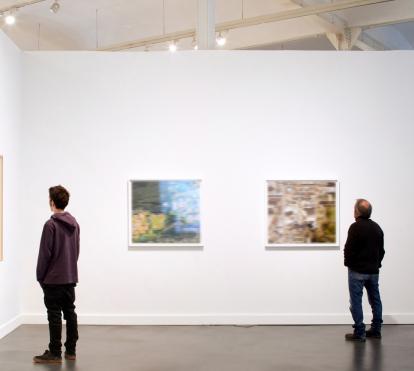
"The day after its liberation by the Americans, I discovered a Kuwait littered by war debris and cadavers of Iraqi soldiers. Their withdrawal must have been a true ordeal." These are the words of Abbas, an Iranian photographer who "writes with light". After visiting 28 countries from Sinkiang to Morocco between 1987 and 1994, Abbas portrayed the resurgence of Islam and the contradictions between an ideology inspired by a mythical past and the universal yearning for modernity and democracy. Under the title Abbas: Visions of Islam, Fundació ”la Caixa” now presents these 99 photographs -in reference to the 99 names and epithets of Allah-, accompanied by excerpts from books by famous historical travellers, and fragments from the diaries of this photojournalist who has been a member of the Magnum Photos agency since 1981. On exhibit at the Municipal Museum of Ourense, the photographs show revolution and war; daily life in the cities; the world of the women, particularly downtrodden by the fundamentalists -Abbas dedicates the exhibition to the women of Afghanistan-; children who attend the Koran schools, the cradle of the most orthodox Islamism; stark landscapes consisting of streets, cemeteries and sanctuaries; protests against the writer Salman Rushdie by European Muslims; demonstrations in support of the chador, prohibited in secular schools... In other words, an eyewitness account of Islam and its peoples. Abbas: Visions of Islam will be open to the public at the Municipal Museum of Ourense (Rúa Lepanto, 8) from 23 October to 17 November 2002. From Sinkiang to Morocco, from London to Timbuktu, including even Mecca, the exhibition Abbas: Visions of Islam reflects the day-to-day life of the Muslims, their spirituality and their mysticism, the rituals of their faith and the political phenomenon that Islam represents today. Taken in 28 countries (Egypt, Afghanistan, Tajikistan, China, Indonesia, Brunei, India, Great Britain, Spain, Algeria, Senegal, Sudan, Israel, Bosnia and Iran, among others), the photographs are displayed together with fragments from the personal diaries of Abbas himself and other historically famous travellers. These texts provide a counterpoint to the images, explaining the context in which a specific photograph was captured. A prime example is that of little Gulbibi ("Queen of the Flowers"), portrayed in Kabul (Afghanistan), and whose startling text states, "Her left foot was amputated as the result of a mine explosion. Her leg and right arm are a mass of raw flesh. Lying on her bed, an icon of suffering and dignity, she has to be given anaesthetic each time her dressing is changed, so intense is her pain." Abbas explains how, in 1987, before leaving Paris to undertake his long journey through these 28 countries, a friend of his a woman recommended that he read the Voyages of Ibn Batuta, the legendary traveller who had roamed Islamic lands centuries before. Abbas discovered an Ibn Batuta who ordered hands to be cut off, who abused the female slaves and who had innocent people whipped. Thus it was that Abbas made a journey of contrasts. His camera captured, for example, a militant feminist who fought against the Family Code in Algeria; the religious fervour of Mecca; the leaders of Dar al-Ulum, the flagship university of orthodox Islam, a branch of which is established in a town in the county of Yorkshire (Great Britain), and so on. Such scenes and accounts reveal the different realities and contradictions of Islam. Of Iranian background, the photographer Abbas lives in Paris and has been a member of the Magnum Photos agency since 1981. Between 1970 and 1978, his work was published in magazines of international scope, reflecting the political and social conflicts of southern hemisphere countries, such as Chile, South Africa, Vietnam, Bangladesh and Biafra. Between 1978 and 1980, he covered the Iranian revolution. His book Iran, la Révolution Confisquée (Clérat, 1979) forced him into a voluntary exile that would last 17 years. Between 1983 and 1986, he travelled to Mexico and published Return to Mexico, Journeys beyond the Mask (W.W. Norton, 1992). Following Allah O Akbar, voyages dans l'Islam militant (1994), and between 1995 and 2000, he visited Christian countries (Voyage en Chrétientés, La Martinière, 2000). He is currently investigating paganism. Some of his solo exhibitions have been hosted by the Musée d'Art Moderne of Teheran (1980), the Escuela de Bellas Artes of Almería (1991), the Centro de la Imagen of Mexico (1994), the Palace Royale of Brussels (1999), the Institut du Monde Arabe of Paris (2001) and the Palazzo Vecchio of Florence (2002). Referring to his work, Abbas writes: "At present, my photography is a reflection that comes to life in action and leads to meditation. Spontaneity the suspended moment intervenes during action, in the viewfinder. A reflection on the subject precedes it. A meditation on finality follows it, and it is here, during this exalting and fragile moment, that the real photographic writing develops, sequencing the images. For this reason, a writer's spirit is necessary to this enterprise. Isn't photography "writing with light"? But with the difference that while the writer possesses his word, the photographer is himself possessed by his photography, by the limit of the real which he must transcend so as not to become its prisoner." Abbas: Visions of IslamFrom 23 October to 17 November 2002Muncipal Museum of OurenseRúa Lepanto, 832005 OurenseThe exhibition is open to the public:Tuesdays to Saturdays, 11:00 a.m. 1:30 p.m. and 6:00 p.m. 9:00 p.m.Sundays, 11:00 a.m. 1:30 p.m.Closed Mondays and holidayswww.fundacio@lacaixa.esAdmission free of charge